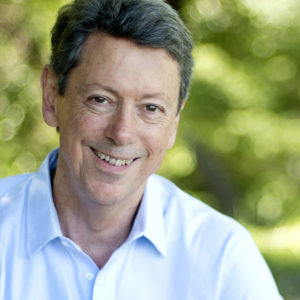 Rick Hanson, PhD is a psychologist, New York Times best-selling author, and Senior Fellow of the Greater Good Science Center at UC Berkeley. He graduated summa cum laude from UCLA and is the founder of the Wellspring Institute for Neuroscience and Contemplative Wisdom. His work has been featured by NPR, CBS, BBC, and many other outlets.
Rick Hanson, PhD is a psychologist, New York Times best-selling author, and Senior Fellow of the Greater Good Science Center at UC Berkeley. He graduated summa cum laude from UCLA and is the founder of the Wellspring Institute for Neuroscience and Contemplative Wisdom. His work has been featured by NPR, CBS, BBC, and many other outlets.
Dr. Hanson recently released his fifth book, Resilient: How to Grow an Unshakable Core of Calm, Strength, and Happiness. It is based in part on his online experiential program, The Foundations of Well-Being*, which focuses on positive neuroplasticity. The program is set up for a year of personal healing, so Dr. Hanson thought in terms of twelve fundamental pillars of well-being, which are also the twelve strengths of resilience in the chapter structure of his book.
In an exclusive interview with GoodTherapy.org, Dr. Hanson speaks about the structure and ideas behind his new book. He shares which practices can help foster resilience inside and outside of therapy and how we can empower ourselves to become more resilient.
1. How do you define resilience, and what drew you to this topic?
Resilience is the capability to recover from adversity, trauma, and setbacks and to keep on going in pursuit of goals and opportunities. We need resilience to survive, but we also need resilience to thrive. To deal with stress, work through conflicts, push through weariness and pain, and deal with a changing world—that’s resilience.
This book is based on my program, The Foundations of Well-Being. If we are not resilient, we are not able to sustain happiness and well-being. Resilience requires inner resources like secure attachment, self-control, grit, gratitude, mindfulness, compassion, [and] confidence. The book is about how to use positive neuroplasticity to grow these resources. And those topics are perennial. They’ve been important in my journey of healing and doing therapy as a clinical psychologist.
These days, people are buffeted by changes that seem out of their control. We’re kind of on our own, which takes us back to some values like self-reliance. The essence of self-reliance is resilience, and the essence of resilience is knowing how to use each day to become a little stronger, wiser, more loving, and happier.
2. What are some characteristics of a resilient mindset versus a non-resilient mindset?
Non-resilient [is] a mindset in which a person feels easily flooded, in which people overreact, and there’s a sense of feeling brittle or shaky. Sometimes people look resilient because they present a good mask, but inside they’re suffering. Over time, that persona will crack.
A resilient mindset feels like an unshakable core of well-being, characterized by a sense of calm, strength, and happiness. You feel confident, open, and willing to take chances, because you know you will recover. You’ll pick yourself up, dust yourself off, and keep going.
Each one of us is like a sailboat. When the waves of life come, do you get rocked, or do you get capsized? The difference is resilience. If a person really wants to contribute to the world, that exposes them to especially large waves. If you’re going to, as Brené Brown puts it, dare greatly, you especially need to be resilient. As a longtime psychologist, I point out that resilience is about meeting needs. And the experience of needs met is well-being.
Each one of us is like a sailboat. When the waves of life come, do you get rocked, or do you get capsized? The difference is resilience.
3. Tell us about our three basic needs, the four primary methods for meeting those needs, and why you decided to structure the book on these founding principles.
We have three basic needs: safety, satisfaction, and connection. We’re often objectively or relatively safe and objectively or relatively satisfied. There’s food [and] a steady paycheck, yet people don’t feel content with what they’ve got. While it’s important to impact the objective conditions around us, it’s critically important to internalize the benefits of experiencing those conditions. Resources enable us to meet needs and create well-being. I needed to think about needs as an organizing framework, which took me into familiar ideas about avoiding pain, approaching pleasure, and attaching to others.
I thought about four ways to have well-being and made up this framework, or the four Rs. First, recognize what’s true in the world and in ourselves. Second, build and use resources of various kinds. Third, regulate ourselves. Last, building on Recognizing, Resourcing, and Regulating, we’ve got to Relate. That gives us a matrix: four ways to meet three needs, twelve inner strengths.
4. How can we utilize both positive and negative experiences from our past to help build resilience?
Thinking about the past is a good way to activate a useful experience. People can think back on good times. They might think about good fortune in their past [to] generate an experience of gratitude. It becomes important, once you’re having that experience, to turn on the inner recorder to help that experience have a beneficial impact that lasts. In terms of how we use the methods in the book to heal, we’re talking about two important things: there can be old pain, and pain from adulthood.
There are four things we can do with old pain. We can witness it mindfully. We can focus on releasing it. [We can] grow resources alongside the pain that soothe it or bring more balance in. In effect, growing flowers next to the weeds in the garden of the mind. The fourth way is to use flowers to pull weeds. In the process of healing, the pain is off to the side, while in the foreground of awareness is a prominent experience that’s matched to the pain. For example, a person could be aware of old feelings of rejection while at the same time, having a large experience of being loved.
5. Why are mindfulness and learning such core principles in the development of a resilient well-being?
Mindfulness is important because we need to be mindful to be aware of beneficial experiences, or opportunities for the acquisition of inner resources which make us resilient. If we’re not mindful, we’re going to lose opportunities. Mindfulness gives us control over who we are becoming. For many people, the mind dwells in resentment, anxiety, or regret. Mindfulness enables us to regulate where our mind dwells. We can notice when our mind is dwelling in a beneficial experience and when it is not. If a person’s not able to be mindful, they’re not able to direct their own process of becoming.
Learning is the strength of strengths because it’s the one that grows the rest of them. If lifelong learning is important, then it becomes important to get good at learning or get good at getting better, because then you can apply that. That kind of central insight and internal commitment is the value of self-reliance. The essence of self-reliance is that you can count on yourself to learn what you can and take the fruits of that with you.
6. As a mental health professional, how can you help someone work on becoming more resilient?
A lot of the ways we help people is we help them get out of situations that bang hard on them every day. We help people get away from things that are bad for them. A major way to help people become more resilient is to help them develop targeted psychological resources, inner strengths, in a deliberate way. As a therapist, I have come back again and again to four questions that create a road map for therapy.
First, what’s the challenge? Even that’s a question therapists are not clearly focused on or there’s not a shared view. Second question is, what inner resource would be useful? It could be self-confidence, anger management, commitment to sobriety, perspective, forgiveness. I think therapists routinely do not have a good answer to that question. And I want to be crystal clear, I’m talking about myself here too. We need to develop and draw upon inner resources that are matched to the challenge. The third and fourth questions follow. How could you, the client, have more experiences of the resource we’re trying to grow in your mind? In the fourth question, how could the person internalize more of those experiences?
I’m not claiming I invented this way of thinking, [but] thinking in the way that I’m describing is really useful. Most therapists, including myself in the past, tend to not use these methods to grow resources inside our clients.
7. What advice would you give someone who wanted to work on building their resilience in therapy?
First, appreciate your therapist. Obviously, therapists vary—as in any profession, there are some who shouldn’t be in [it]. Without putting your therapist on a pedestal, recognize they’re human and they’re trying, too.
As a client, you can help yourself multiple times in a therapy session and many times between appointments. You can spotlight experiences that are beneficial to you, such as a moment of insight or feeling soothed while talking with your therapist. When you’re having experiences that are keepers, shine the spotlight on them and take in the good.
Three things tend to maximize the impact of the beneficial experience. [First], keep the experience going for a breath or two or longer—keep those neurons firing together so they wire together. Second, try to feel it in your body as much as possible. The more embodied the experience, the greater the impact. Third, focus on what’s rewarding about the experience. Focusing on what’s rewarding will increase activity of dopamine and norepinephrine, which will flag the experience as a keeper.
A major way to help people become more resilient is to help them develop targeted psychological resources, inner strengths, in a deliberate way.
8. What can we do to help loved ones strengthen their resilience?
One, try not to wear them down. Two, we can help loved ones have key experiences to the extent that we influence them. We can encourage them, help them feel cared about, help them feel they are capable. Without trying to play therapist, we can help them stay with those experiences rather than skittering on to the next thing. That’s the change process: experience what you want to grow and help it affect you in a lasting way.
We can’t make people have experiences that are useful. But through encouraging useful experiences and staying with the experience, celebrating with them—that’s a natural way to help loved ones. If it feels appropriate, it’s useful to share information. We can share with others, “Hey, you can help your brain change for the better in a simple way that’s grounded in science. It’s to experience what you want to develop in yourself and help it land. And it’s up to you if you’re going to do it.”
9. What was it like working with your son on this book? How did collaborating with him influence your typical writing process?
It was awesome. Writing a book with your dad, and it’s your dad’s fifth book—I’m not sure I would have wanted to have done that with my own father. And he was just great. He was patient with me, and he added tremendous value. He wrote major drafts for the book; he edited it. It was great for me to have a collaborator.
Some things I’ll mention that people might find amusing. One is, as a long-time therapist, certain things seem obvious, and I would just say them in a word or a sentence. And he would say “No, no, no—Dad, you got to unpack that sentence, because that’s a really big idea and you’re blowing by it at 90 miles an hour.” That was useful. Another thing he did is, I have some “dad-isms” that go back to my hippie days. He’d go, “No, Dad, you’ve got to come into the 21st century here.” It was fantastic. He deserves full credit.
10. How has writing this book helped you reflect on your own resilience?
The book is very personal and quite revealing about myself. It led me to reflect on my own childhood and the roots of my own resilience. And by reflecting on those roots, I’m more conscious, more able to draw upon them, which has made me more resilient. In a deep way, the book is about how to deal with the challenges of life with a fundamental inner peace. What does it feel like to have that unshakable core, so that even as people challenge you or you get criticism, deep down you feel at peace. And much as I’ve said for therapy clients, it enabled me to have experiences which I could then take into myself.
11. Anything else you’d like to add?
The thing I would emphasize as a takeaway: evidence for mental change is evidence for neural change. At this stage, there is tremendous evidence for the benefits of practice of one kind or another, including going to see a therapist. And it’s hopeful to appreciate that ours is not, as Freud put it, an impossible profession. Our efforts as therapists or the efforts of our clients can and do bear fruit. There are little things we can do every day to learn, grow, heal, and develop, and knowing that is a factor of resilience.
*This page contains an affiliate link for The Foundations of Well-Being online program, which means GoodTherapy.org receives financial compensation if you make a purchase using this link.
© Copyright 2018 GoodTherapy.org. All rights reserved. Permission to publish granted by GoodTherapy.org Staff

 How Perseverance and Resilience Relate to the Window of Tolerance
How Perseverance and Resilience Relate to the Window of Tolerance Strength in the Face of Adversity: Practicing Resilience in Daily Life
Strength in the Face of Adversity: Practicing Resilience in Daily Life Psychological Spinach: Building Resilience by Embracing Your Truth
Psychological Spinach: Building Resilience by Embracing Your Truth